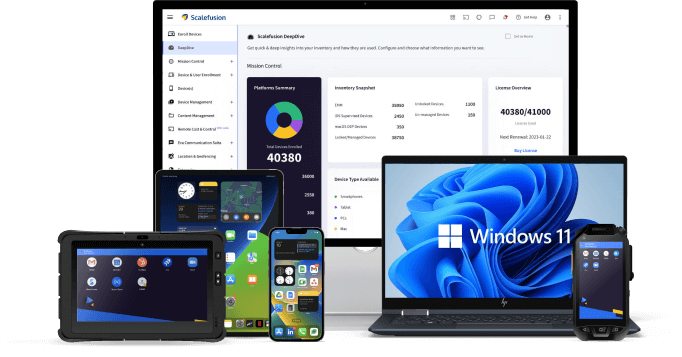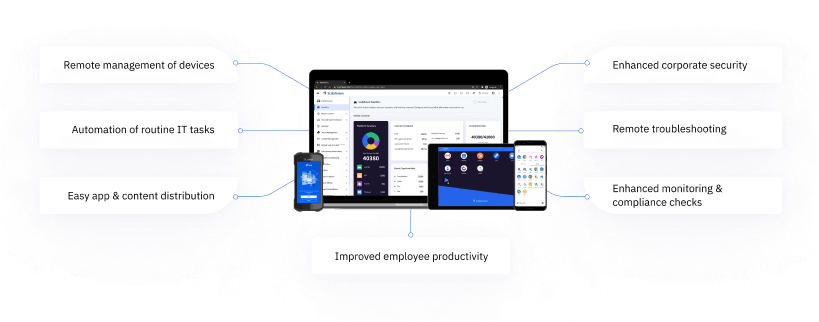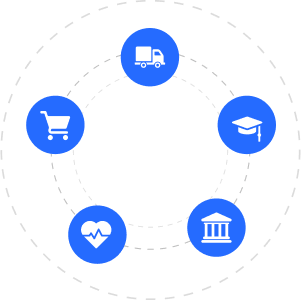What is Mobile Device Management (MDM) Software?
Explore this guide to understand its importance, functionality, benefits, implementation, industry use cases, and tips for choosing an MDM provider and making informed decisions on deploying MDM in your enterprise.
Try for Free Buyer’s Guide

Evolution of MDM: A Brief History
The evolution of Mobile Device Management (MDM) began in the early 2000s with the basic management of devices like BlackBerry phones, focusing on simple security measures such as remote wipes and email configuration. As smartphones and tablets like the iPhone and Android devices became more prevalent, MDM solutions expanded to include advanced security policies, application management, and support for the Bring Your Own Device (BYOD) trend. This period saw the standardization of MDM capabilities across various operating systems, making it easier to manage a diverse array of devices.
In the 2010s, MDM evolved into Unified Endpoint Management (UEM), integrating the management of smartphones, tablets, and traditional PCs into a single platform. The rise of remote work, accelerated by the COVID-19 pandemic, further transformed MDM, emphasizing remote deployment and enhanced security measures. Today, MDM solutions incorporate AI and automation for predictive analytics and proactive security, focusing on balancing robust security with a seamless user experience, and adapting to manage emerging technologies like 5G, IoT, and wearable devices.
What is MDM Software?
MDM software, or Mobile Device Management software, is a tool used by organizations to manage, monitor, and secure mobile devices such as smartphones, tablets, and laptops. This software enables IT departments to control and protect data across a fleet of devices, ensuring they are used safely and effectively within the company.
MDM software presents a centralized platform for IT admins to push enterprise policies on bulk devices, monitor compliance, and provision devices with business resources remotely. It helps IT admins automate several device management processes and reduce the IT workload. It also helps IT admins manage diverse device types remotely without the need for manual configuration.
MDM software is available in the market via multiple vendors that provide both on-premise as well as cloud-based MDM solutions. However, considering the dynamic nature of today's work environment and enterprise mobility gaining pace, a majority of businesses prefer opting for cloud-based MDM solutions.
Why is MDM Important for Enterprises?
Mobile Device Management is an important process of provisioning devices with corporate resources and pushing enterprise policies on the device fleets. With the growing use of mobile devices of diverse types, employees access corporate networks and exchange sensitive business information on a daily basis. Mobile Device Management is crucial to configure enterprise-specific security policies on these devices.
In today’s world, businesses have to suffer massive revenue losses and legal penalties for losing confidential business data. An efficient mobile device management strategy is a critical element in ensuring the secure and appropriate use of corporate data. IT admins are tasked with the responsibility of managing, provisioning, securing and monitoring their organization’s devices.
What is MDM Software?
MDM is software that allows IT admins to simplify the process of mobile device management. Managing a large number of devices is a complex and tedious task. MDM software presents a centralized platform for IT admins to push enterprise policies on bulk devices, monitor compliances and provision devices with business resources remotely. MDM software helps IT admins automate several device management processes and reduce the IT workload. It also helps IT admins to manage diverse device types remotely without the need for manual configuration.
MDM software is available in the market via multiple vendors that provide both on-premise as well as cloud-based MDM solutions. However, considering the dynamic nature of today’s work environment and enterprise mobility gaining pace, a majority of businesses prefer opting for cloud-based MDM solutions.
Get Your Free MDM Buyer’s Guide Copy Now!
How Does MDM Solution Work?
Mobile device management solutions work on the client-server architecture to push security configurations, business resources, enterprise policies, etc., on bulk devices over the air. Generally, company IT admins can leverage role-based access to the MDM console, with which they can create one or more device profiles with diverse configurations and operating systems. MDM solutions also enable IT admins to easily onboard employees on an organizational level with zero-touch enrollment options.
Once enrolled, IT admins can push the pre-configured device profiles on a large number of devices via the MDM dashboard. This increases the control and visibility of company-owned and BYOD devices. IT admins can monitor locations, usage behavior and compliance violations, all from a single platform. Be it commercial devices such as laptops, smartphones or tablets, or custom devices such as POS systems, digital signages, or kiosks belonging to various OS types such as Android, iOS, macOS or Windows, IT admins can manage all these diverse device types from a single portal.
Benefits of MDM Software
Mobile device management or endpoint management is used for streamlining mobility and remote management of devices. Let’s look at how Mobile Device Management solutions benefit businesses.

Advantages of MDM
Remote management of devices
IT admins can create diverse policies for company-owned or BYOD management. You can also deliver an out-of-the-box experience to your employees with pre-configured, ready-to-use company-owned devices.
Enhanced corporate and mobile security
You can create and push diverse network, device and data security configurations from the MDM dashboard to keep mishaps like malware at bay. As an additional security measure, lost or stolen devices can be locked and their data can be wiped to secure corporate data.
Automation of routine IT tasks
Several crucial but redundant IT tasks that take up all the IT time can be automated using MDM tools, such as patch management, timely OS updates, etc, to protect data and apps, keeping security threats cornered.
Remote troubleshooting
You can reach out to your remote employees via an MDM agent in no time and offer quick remote support to ensure quick issue resolution.
OTA app & content management
You can push apps and content on mobile devices silently, as well as configure apps, update apps and track app data usage. You can manage mobile devices by remotely pushing files of diverse formats, including documents, images, presentations and videos, on a large number of devices. Content and application management for devices have become the need of the hour for IT teams and MDM supports this need.
Enhanced monitoring & compliance checks
MDM solutions allow IT admins to gain finer visibility of their dispersed devices. You can track locations, monitor policy compliance, as well as track device usage and vitals.
Improved employee productivity
You can lock your employees' devices into single or multiple selective apps and allow or block specific websites to ensure maximum productivity at work. This capability can also be leveraged to turn commercial devices into purpose-specific kiosks.
Simplify Mobile Device Management (MDM) Implementation
The hallmark of mobile device management is to simplify the management of devices. Implementing a mobile device management solution into an organizational tech stack is simple. There are just a few things IT admins need to keep in mind to smoothly onboard an MDM solution.
Set MDM Goals
The stepping stone to implementing an MDM solution is to have a complete overview of the entire device inventory your employees use and the nature of their work. List out devices you want to manage and identify the groups you want to divide them into. It could range from operating systems to device location or whether devices are corporate-owned or employee-owned (BYOD).
Set the Right Policies
An MDM platform functions best when IT admins have clear-cut device management policies in place so that there are no deviations or surprises. Be it data or device security, set the right policies based on end user and purpose.
Don’t Ignore UI/UX
You employees must love the MDM software you want them to use. Thus, ensure that the UI/UX is not compromised as you prioritize security and other imperatives. Look for an MDM vendor that lets you be in control through varied levels of customization. App integrations and their appearance is another factor worth considering here for your fleet of mobile devices.
Flexibility and Cross-Platform Experience
Having a rigid MDM solution can backfire quickly when device heterogeneity increases at the workplace. It’s best to opt for a solution that delivers the same functionalities and experience across all the platforms—Windows, Android, iOS, Mac, and Linux. The device enrolment process must also be safe and swift. There must be flexible deployment options too—cloud and on-prem.
Scalability
One of the most important factors to consider when implementing a mobile device management solution is the scalability it offers. The MDM solution must accommodate the addition of devices in the most streamlined manner. Even when devices retire or employees leave, the removal and reassignment of devices have to be hassle-free.
Support & Training
The best of MDM solutions can leave you puzzled without proper training and post-sales support. Choose an MDM provider that offers extensive training and support so IT admins are not left wondering while managing devices. Best MDM providers must be there to help you anytime from anywhere, especially in the age of remote work.
MDM Deployment: Cloud or On-premises
Choosing whether to have a mobile device management or MDM solution over the cloud or on-premise should be need-based. There are pros and cons involved in both scenarios because SaaS adoption has soared globally. Perhaps, the major differentiator between the two models is the associated costs. The whole concept of the cloud was tethered to the fact that it saves IT teams a lot of time and money.
A decade or so ago, most IT teams of organizations would consider cloud vs. on-prem an easy choice. The choice was ‘cloud’ for mobile management. Today, as personal data security and privacy laws continue to make a business impact, the on-prem deployment model is regaining its fair share.
Cloud Deployment:
Pros
-
Zero upfront capital
-
Scalable
-
Reduces IT workload
Cons
-
Defined access to infrastructure and server
-
Dependable on network connectivity
-
Increased cost when bandwidth use increases
On-premise Deployment:
Pros
-
Lower bandwidth cost
-
Better privacy and security
-
Extended hardware control
Cons
-
High initial capital investment
-
Organization is responsible for compliance
-
Extra IT resources needed for maintenance
Experience Mobile Device Management Driven by Simplicity
MDM Industry Use-Cases
Mobile Device Management is not specific to industries. Today, every major industrial sector relies heavily on the use of mobile devices. Let’s have a look at the diverse MDM industry use cases.

Logistics & Transportation
The logistics and transportation industry benefits largely from MDM solutions. The supply chain, in general, involves a large mobile workforce and logistics is a big part of it. MDM solutions help logistics businesses keep track of their constantly moving device fleets, ensure maximum productivity and protect sensitive business information stored on employees’ mobile devices.
Healthcare
MDM solutions help the healthcare sector execute modern-day trends such as m-health and telehealth effortlessly. Healthcare IT can ensure the protection and privacy of sensitive patient data and manage their diverse digital devices with ease.
Education
Distance learning and remote education have surged, especially since the pandemic hit us. MDM software has enabled schools and universities to manage thousands of student and staff devices, share learning material remotely and set device restrictions to prevent distractions in students.
Retail
The modern-day retail sector makes use of several custom devices such as digital signages, POS and mPOS systems, digital kiosks, etc. MDM software not only lets you manage your retail devices remotely but also helps you to turn commercial devices into dedicated kiosks with MDM-enabled kiosk mode.
BFSI
The Banking and financial industry has always been a high-security sector. You can ensure extensive security on sensitive data and prevent unauthorized access.
Who are MDM Providers?
An MDM provider is a third-party mobile device management vendor that offers a device management platform to businesses, managed service providers, OEMs and resellers on a subscription model. Based on your business requirements, MDM providers extend several license plans that can help your IT teams manage your device lifecycles with ease.
What Must You Look For in an MDM Provider?
There are several MDM providers in the market today. Mobile device management solutions are in great demand, but it is important for businesses to evaluate their needs and pick the right solution provider.
Here are some factors to consider before picking an MDM provider:
-
Free trial period to test the features and functioning of the software
-
Clear pricing structure with no hidden charges
-
Round-the-clock technical support
-
Product demos
-
After-sales support
Scalefusion Mobile Device Management Features
Scalefusion is the ideal Mobile Device Management (MDM) solution that caters to diverse device management needs for various industries. Let’s look at some powerful capabilities that Scalefusion offers to simplify enterprise mobility.
Zero-touch enrollment
Scalefusion offers zero-touch enrollment options for Android, Apple and Windows enterprise mobile devices to help IT admins initiate out-of-the-box policy applications.
BYOD management
Most employees access their work emails and other corporate data using their personal devices like laptops and smartphones. Scalefusion offers efficient BYOD Management that helps IT admins configure containerization policies to secure business data, as well as maintain employee privacy.
Kiosk management
Several industries such as retail, hospitality, healthcare, etc., have begun using unattended digital devices such as digital signages, digital kiosks, etc. Scalefusion offers kiosk management capabilities to help businesses manage not just employees’ devices but also unattended dedicated devices.
Rugged device management
Constructions, minings, warehousing and manufacturing are some of the few industries that have a field workforce. Such industries prefer investing in rugged devices that can withstand harsh outdoor conditions. Scalefusion MDM supports rugged device management to make your rugged devices enterprise-ready.
Mobile Threat Defense
With growing cyber threats, businesses need to take their corporate security to new levels. Scalefusion MDM is all set to offer integrated Mobile Threat Defense (MTD) to protect mobile devices, networks and apps against cyber threats with automated encryption checks, early anomaly detection and fast corrective actions.
Multi-platform and device support
Be it smartphones, laptops and tablets, digital signages, POS systems, digital kiosks, or custom and rugged devices, all your diverse device types can be managed with a single platform. Scalefusion supports all the major OS types, including Android, iOS, macOS and Windows 10.
Conclusion:
Scalefusion MDM is designed to cater to modern-day device management needs. Your IT teams can experience streamlined device management, deploy powerful security policies, free-up IT time with task automation, and much more using a single comprehensive platform.
Frequently Asked Questions (FAQs)
Device management involves overseeing and securing a range of devices within an organization. Mobile Device Management (MDM) specifically focuses on mobile devices like smartphones and tablets. It encompasses device enrollment, mobile application management, and policy management to ensure security and compliance. Unified Endpoint Management (UEM) extends beyond mobile devices to include desktops, laptops, and IoT devices, offering a comprehensive management framework. Identity and Access Management (IAM) solutions play a crucial role in both MDM and UEM, providing secure access to applications and data. Choosing the right MDM or UEM tool involves evaluating device management functionality to meet organizational needs.
MDM supports remote work by enabling automated device enrollment and configuration, ensuring mobile phones and personal mobile devices used for work adhere to corporate policies. MDM solutions offer mobile device security features, such as remote wipe capabilities, to protect data stored on the device if it is lost or stolen. Additionally, MDM lets IT administrators deploy and manage mobile applications remotely, ensuring employees have access to necessary tools without compromising security. MDM strategies include managing device settings and monitoring device usage, which are essential for maintaining productivity and security in a remote work environment.
MDM focuses on the administration of mobile devices, providing tools for mobile content management, device deployment, and app management. It addresses security and compliance for mobile phones, tablets, and other mobile devices within an organization. On the other hand, UEM encompasses MDM and extends to managing all endpoints, including desktops, laptops, and IoT devices. UEM integrates identity and access management solutions and offers a more holistic approach to device management. Both MDM and UEM solutions aim to optimize device management but differ in scope and device management functionality.
MDM solutions integrate with existing IT infrastructure by connecting to identity and access management systems, directory services, and network security tools. This integration allows for seamless device enrollment, policy management, and mobile application management. For instance, MDM tools can synchronize with Active Directory to enforce user-specific policies and access controls. Apple device management is facilitated through integration with Apple Business Manager, streamlining device deployment and management. Effective MDM solutions ensure that all mobile devices, whether personal or corporate-owned, comply with organizational standards without disrupting the existing IT framework.
When choosing an MDM solution, consider the device management functionality required for your organization, including mobile application management, device settings configuration, and mobile device security. Evaluate the ability to manage a variety of devices, from mobile phones to tablets and Apple devices. Ensure the MDM solution supports automated device enrollment (ADE) and offers comprehensive policy management features. Additionally, consider how the solution integrates with existing IT infrastructure, including identity and access management systems. Best practices for mobile device management involve selecting an MDM solution that can scale with your organization’s needs and provide robust security and compliance features.
Implementing an MDM solution can present several challenges, including device compatibility issues and user resistance to device management policies. Managing a diverse array of devices, such as personal mobile devices for work, requires a robust MDM strategy to ensure security and compliance. Integrating MDM solutions with existing IT infrastructure and identity and access management solutions can be complex. Additionally, ensuring that mobile device management tools are up-to-date with the latest security features is critical. Without an MDM solution, managing device data, deploying updates, and enforcing security policies become difficult, posing risks to organizational security and productivity.

&textColor=rgba(0,0,0,0))